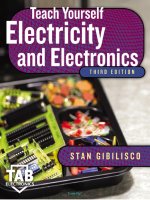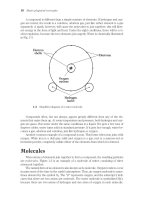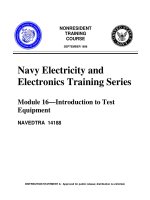Teach Yourself Electricity and Electronics
Bạn đang xem bản rút gọn của tài liệu. Xem và tải ngay bản đầy đủ của tài liệu tại đây (7.06 MB, 748 trang )
TEAMFLY
Team-Fly
®
Teach Yourself
Electricity and
Electronics
This page intentionally left blank
Teach Yourself
Electricity and
Electronics
Third Edition
Stan Gibilisco
McGraw-Hill
New York Chicago San Francisco Lisbon London Madrid
Mexico City Milan New Delhi San Juan Seoul
Singapore Sydney Toronto
Copy right
2002, 1997, 1993 by The McGraw-Hill Com p anies, Inc. All rights reserved. Manufactured in
the United States of Am erica. Except as perm itted under the United States Copy right Act of 1976, no part
of this publication m a y be reproduced or distributed in any form or by any m eans, or stored in a database
or retrieval sy stem , without the prior written perm ission of the publisher.
0-07-138939-3
The m a terial in this eBook also appears in the print version of this title: 0-07-137730-1.
All tradem arks are tradem arks of their respective owne rs. Rather than put a tradem ark sy m bol after every
occurrence of a tradem arked nam e , we use nam es in an editorial fashion only , and to the benefit of the
tradem ark owner, with no intention of infringem e nt of the tradem ark. Where such designations appear in
this book, they have been printed with initial caps.
McGraw-Hill eBooks are available at special quantity discounts to use as prem ium s and sales prom otions,
or for use in corporate training program s. For m o re inform ation, please contact George Hoare, Special
Sales, at george_hoare@m cgra w-hill.com or (212) 904-4069.
TERMS OF USE
This is a copy righted work and The McGraw-Hill Co m p anies, Inc. ("McGraw-Hill") and its licensors
reserve all rights in and to the work. Use of this work is subject to these term s. Except as perm itted under
the Copy right Act of 1976 and the right to store and re trieve one copy of the work, y ou m a y not decom p ile,
disassem ble, reverse engineer, reproduce, m odify , creat e derivative works based upon, transm it, distribute,
dissem inate, sell, publish or sublicense the work or an y part of it without McGraw-Hills prior consent. You
m a y use the work for y our own noncom m e rcial and pers onal use; any other use of the work is strictly
prohibited. Your right to use the work m a y be term inated if y ou fail to com p ly with these term s.
THE WORK IS PROVIDED "AS IS." McGRAW-HILL AND ITS LICENSORS MAKE NO
GUARANTEES OR WARRANTIES AS TO THE ACCURACY, ADEQUACY OR COMPLETENESS
OF OR RESULTS TO BE OBTAINED FROM USING THE WORK, INCLUDING ANY
INFORMATION THAT CAN BE ACCESSED THROUGH THE WORK VIA HYPERLINK OR
OTHERWISE, AND EXPRESSLY DISCLAIM ANY WARRANTY, EXPRESS OR IMPLIED,
INCLUDING BUT NOT LIMITED TO IMPLIED WARRANTIES OF MERCHANTABILITY OR
FITNESS FOR A PARTICULAR PURPOSE. McGraw-Hill and its licensors do not warrant or guarantee
that the functions contained in the work will m eet y our requirem e nts or that its operation will be
uninterrupted or error free. Neither McGraw-Hill nor its licensors shall be liable to y ou or any one else for
any inaccuracy , error or om ission, regardless of cause, in the work or for any dam a ges resulting therefrom .
McGraw-Hill has no responsibility for the content of any inform ation accessed through the work. Under no
circum stances shall McGraw-Hill and/or its licensors be liable for any indirect, incidental, special,
punitive, consequential or sim ilar dam a ges that result fro m the use of or inability to use the work, even if
any of them has been advised of the possibility of su ch dam a ges. This lim itation of liability shall apply to
any claim or cause whatsoever whet her such claim or cause arises in contract, tort or otherwise.
DOI: 10.1036/0071389393
To Tony, Tim, and Samuel
from Uncle Stan
v
This page intentionally left blank
Contents
Preface xix
Part 1 Direct current
1 Basic physical concepts 3
Atoms 3
Protons, neutrons, and the atomic number 4
Isotopes and atomic weights 4
Electrons 5
Ions 5
Compounds 9
Molecules 10
Conductors 11
Insulators 11
Resistors 13
Semiconductors 14
Current 15
Static electricity 15
Electromotive force 16
Nonelectrical energy 18
Quiz 19
2 Electrical units 23
The volt 23
Current flow 24
The ampere 26
Resistance and the ohm 26
Conductance and the siemens 28
vii
Power and the watt 29
Energy and the watt hour 31
Other energy units 33
ac Waves and the hertz 34
Rectification and fluctuating direct current 35
Safety considerations in electrical work 37
Magnetism 38
Magnetic units 39
Quiz 40
3 Measuring devices 44
Electromagnetic deflection 44
Electrostatic deflection 46
Thermal heating 47
Ammeters 48
Voltmeters 49
Ohmmeters 51
Multimeters 53
FET and vacuum-tube voltmeters 54
Wattmeters 54
Watt-hour meters 55
Digital readout meters 56
Frequency counters 57
Other specialized meter types 57
Quiz 60
4 Basic dc circuits 65
Schematic symbols 65
Schematic diagrams 67
Wiring diagrams 68
Voltage/current/resistance circuit 68
Ohm’s Law 69
Current calculations 69
Voltage calculations 71
Resistance calculations 71
Power calculations 72
Resistances in series 73
Resistances in parallel 74
Division of power 75
Resistances in series-parallel 75
Resistive loads in general 77
Quiz 77
5 Direct-current circuit analysis 82
Current through series resistances 82
Voltages across series resistances 83
viii Contents
Voltage across parallel resistances 85
Currents through parallel resistances 86
Power distribution in series circuits 88
Power distribution in parallel circuits 88
Kirchhoff’s first law 89
Kirchhoff’s second law 91
Voltage divider networks 92
Quiz 95
6 Resistors 99
Purpose of the resistor 99
The carbon-composition resistor 102
The wirewound resistor 103
Film type resistors 104
Integrated-circuit resistors 104
The potentiometer 105
The decibel 107
The rheostat 109
Resistor values 110
Tolerance 110
Power rating 110
Temperature compensation 111
The color code 112
Quiz 114
7 Cells and batteries 118
Kinetic and potential energy 118
Electrochemical energy 118
Primary and secondary cells 119
The Weston standard cell 120
Storage capacity 120
Common dime-store cells and batteries 122
Miniature cells and batteries 124
Lead-acid cells and batteries 125
Nickel-cadmium cells and batteries 125
Photovoltaic cells and batteries 127
How large a battery? 128
Quiz 130
8 Magnetism 134
The geomagnetic field 134
Magnetic force 135
Electric charge in motion 136
Flux lines 136
Magnetic polarity 137
Dipoles and monopoles 139
Contents ix
Magnetic field strength 139
Permeability 142
Retentivity 142
Permanent magnets 143
The solenoid 144
The dc motor 145
Magnetic data storage 146
Quiz 149
Test: Part 1 153
Part 2 Alternating current
9 Alternating current basics 165
Definition of alternating current 165
Period and frequency 165
The sine wave 167
The square wave 167
Sawtooth waves 167
Complex and irregular waveforms 169
Frequency spectrum 170
Little bits of a cycle 172
Phase difference 173
Amplitude of alternating current 173
Superimposed direct current 175
The ac generator 176
Why ac? 178
Quiz 178
10 Inductance 183
The property of inductance 183
Practical inductors 184
The unit of inductance 185
Inductors in series 185
Inductors in parallel 186
Interaction among inductors 187
Effects of mutual inductance 188
Air-core coils 189
Powdered-iron and ferrite cores 190
Permeability tuning 190
Toroids 190
Pot cores 192
Filter chokes 192
Inductors at audio frequency 193
Inductors at radio frequency 193
Transmission-line inductors 193
x Contents
TEAMFLY
Team-Fly
®
Unwanted inductances 195
Quiz 195
11 Capacitance 199
The property of capacitance 199
Practical capacitors 201
The unit of capacitance 201
Capacitors in series 202
Capacitors in parallel 203
Dielectric materials 204
Paper capacitors 204
Mica capacitors 205
Ceramic capacitors 205
Plastic-film capacitors 206
Electrolytic capcitors 206
Tantalum capacitors 206
Semiconductor capacitors 207
Variable capacitors 207
Tolerance 209
Temperature coefficient 210
Interelectrode capacitance 210
Quiz 211
12 Phase 215
Instantaneous voltage and current 215
Rate of change 216
Sine waves as circular motion 217
Degrees of phase 218
Radians of phase 221
Phase coincidence 221
Phase opposition 222
Leading phase 222
Lagging phase 224
Vector diagrams of phase relationships 225
Quiz 226
13 Inductive reactance 231
Coils and direct current 231
Coils and alternating current 232
Reactance and frequency 233
Points in the RL plane 234
Vectors in the RL plane 235
Current lags voltage 237
Inductance and resistance 238
How much lag? 240
Quiz 243
Contents xi
14 Capacitive reactance 247
Capacitors and direct current 247
Capacitors and alternating current 248
Reactance and frequency 249
Points in the RC plane 251
Vectors in the RC plane 253
Current leads voltage 254
How much lead? 256
Quiz 259
15 Impedance and admittance 264
Imaginary numbers 264
Complex numbers 265
The complex number plane 266
The RX plane 269
Vector representation of impedance 270
Absolute-value impedance 272
Characteristic impedance 272
Conductance 275
Susceptance 275
Admittance 276
The GB plane 277
Vector representation of admittance 279
Why all these different expressions? 279
Quiz 280
16 RLC circuit analysis 284
Complex impedances in series 284
Series RLC circuits 288
Complex admittances in parallel 289
Parallel GLC circuits 292
Converting from admittance to impedance 294
Putting it all together 294
Reducing complicated RLC circuits 295
Ohm’s law for ac circuits 298
Quiz 301
17 Power and resonance in ac circuits 305
What is power? 305
True power doesn’t travel 307
Reactance does not consume power 308
True power, VA power and reactive power 309
Power factor 310
Calculation of power factor 310
How much of the power is true? 313
xii Contents
Power transmission 315
Series resonance 318
Parallel resonance 319
Calculating resonant frequency 319
Resonant devices 321
Quiz 323
18 Transformers and impedance matching 327
Principle of the transformer 327
Turns ratio 328
Transformer cores 329
Transformer geometry 330
The autotransformer 333
Power transformers 334
Audio-frequency transformers 336
Isolation transformers 336
Impedance-transfer ratio 338
Radio-frequency transformers 339
What about reactance? 341
Quiz 342
Test: Part 2 346
Part 3 Basic electronics
19 Introduction to semiconductors 359
The semiconductor revolution 359
Semiconductor materials 360
Doping 362
Majority and minority charge carriers 362
Electron flow 362
Hole flow 363
Behavior of a P-N junction 363
How the junction works 364
Junction capacitance 366
Avalanche effect 366
Quiz 367
20 Some uses of diodes 370
Rectification 370
Detection 371
Frequency multiplication 372
Mixing 373
Switching 374
Voltage regulation 374
Amplitude limiting 374
Contents xiii
Frequency control 376
Oscillation and amplification 377
Energy emission 377
Photosensitive diodes 378
Quiz 380
21 Power supplies 383
Parts of a power supply 383
The power transformer 384
The diode 385
The half-wave rectifier 386
The full-wave, center-tap rectifier 387
The bridge rectifier 387
The voltage doubler 389
The filter 390
Voltage regulation 392
Surge current 393
Transient suppression 394
Fuses and breakers 394
Personal safety 395
Quiz 396
22 The bipolar transistor 400
NPN versus PNP 400
NPN biasing 402
PNP biasing 404
Biasing for current amplification 404
Static current amplification 405
Dynamic current amplification 406
Overdrive 406
Gain versus frequency 407
Common-emitter circuit 408
Common-base circuit 409
Common-collector circuit 410
Quiz 411
23 The field-effect transistor 416
Principle of the JFET 416
N-channel versus P-channel 417
Depletion and pinchoff 418
JFET biasing 419
Voltage amplification 420
Drain current versus drain voltage 421
Transconductance 422
The MOSFET 422
xiv Contents
Depletion mode versus enhancement mode 425
Common-source circuit 425
Common-gate circuit 426
Common-drain circuit 427
A note about notation 429
Quiz 429
24 Amplifiers 433
The decibel 433
Basic bipolar amplifier circuit 437
Basic FET amplifier circuit 438
The class-A amplifier 439
The class-AB amplifier 440
The class-B amplifier 441
The class-C amplifier 442
PA efficiency 443
Drive and overdrive 445
Audio amplification 446
Coupling methods 447
Radio-frequency amplification 450
Quiz 453
25 Oscillators 457
Uses of oscillators 457
Positive feedback 458
Concept of the oscillator 458
The Armstrong oscillator 459
The Hartley circuit 459
The Colpitts circuit 461
The Clapp circuit 461
Stability 463
Crystal-controlled oscillators 464
The voltage-controlled oscillator 465
The PLL frequency synthesizer 466
Diode oscillators 467
Audio waveforms 467
Audio oscillators 468
IC oscillators 469
Quiz 469
26 Data transmission 474
The carrier wave 474
The Morse code 475
Frequency-shift keying 475
Amplitude modulation for voice 478
Single sideband 480
Contents xv
Frequency and phase modulation 482
Pulse modulation 485
Analog-to-digital conversion 487
Image transmission 487
The electromagnetic field 490
Transmission media 493
Quiz 495
27 Data reception 499
Radio wave propagation 499
Receiver specifications 502
Definition of detection 504
Detection of AM signals 504
Detection of CW signals 505
Detection of FSK signals 506
Detection of SSB signals 506
Detection of FM signals 506
Detection of PM signals 508
Digital-to-analog conversion 509
Digital signal processing 510
The principle of signal mixing 511
The product detector 512
The superheterodyne 515
A modulated-light receiver 517
Quiz 517
28 Integrated circuits and data storage media 521
Boxes and cans 521
Advantages of IC technology 522
Limitations of IC technology 523
Linear versus digital 524
Types of linear ICs 524
Bipolar digital ICs 527
MOS digital ICs 527
Component density 529
IC memory 530
Magnetic media 532
Compact disks 535
Quiz 535
29 Electron tubes 539
Vacuum versus gas-filled 539
The diode tube 540
The triode 541
Extra grids 542
Some tubes are obsolete 544
xvi Contents
Radio-frquency power amplifiers 544
Cathode-ray tubes 546
Video camera tubes 547
Traveling-wave tubes 549
Quiz 551
30 Basic digital principles 555
Numbering systems 555
Logic signals 557
Basic logic operations 559
Symbols for logic gates 561
Complex logic operators 561
Working with truth tables 562
Boolean algebra 564
The flip-flop 564
The counter 566
The register 567
The digital revolution 568
Quiz 568
Test: Part 3 572
Part 4 Advanced electronics and related technology
31 Acoustics, audio, and high fidelity 583
Acoustics 583
Loudness and phase 585
Technical considerations 587
Basic components 589
Other components 591
Specialized systems 596
Recorded media 597
Electromagnetic interference 601
Quiz 602
32 Wireless and personal communications systems 606
Cellular communications 606
Satellite systems 608
Acoustic transducers 612
Radio-frequency transducers 613
Infrared transducers 614
Wireless local area networks 615
Wireless security systems 616
Hobby radio 617
Noise 619
Quiz 620
Contents xvii
33 Computers and the Internet 624
The microprocessor and CPU 624
Bytes, kilobytes, megabytes, and gigabytes 626
The hard drive 626
Other forms of mass storage 628
Random-access memory 629
The display 631
The printer 633
The modem 635
The Internet 636
Quiz 640
34 Robotics and artificial intelligence 644
Asimov’s three laws 644
Robot generations 645
Independent or dependent? 646
Robot arms 648
Robotic hearing and vision 652
Robotic navigation 657
Telepresence 661
The mind of the machine 663
Quiz 665
Test: Part 4 669
Final exam 679
Appendices
A Answers to quiz, test, and exam questions 697
B Schematic symbols 707
Suggested additional reference 713
Index 715
xviii Contents
Copyright © 2002, 1997, 1993 by The McGraw-Hill Companies.
Click here for terms of use.
Preface
This book is for people who want to learn basic electricity, electronics, and com-
munications concepts without taking a formal course. It can also serve as a class-
room text. This third edition contains new material covering acoustics, audio,
high-fidelity, robotics, and artificial intelligence.
I recommend you start at the beginning of this book and go straight through.
There are hundreds of quiz and test questions to fortify your knowledge and help
you check your progress as you work your way along.
There is a short multiple-choice quiz at the end of every chapter. You may (and
should) refer to the chapter texts when taking these quizzes. When you think you’re
ready, take the quiz, write down your answers, and then give your list of answers to
a friend. Have the friend tell you your score, but not which questions you got wrong.
The answers are listed in the back of the book. Stick with a chapter until you get
most of the answers correct. Because you’re allowed to look at the text during
quizzes, the questions are written so that you really have to think before you write
down an answer. Some are rather difficult, but there are no trick questions.
This book is divided into four major sections: Direct Current, Alternating Cur-
rent, Basic Electronics, and Advanced Electronics and Related Technology. At the
end of each section is a multiple-choice test. Take these tests when you’re done with
the respective sections and have taken all the chapter quizzes. Don’t look back at the
text when taking these tests. A satisfactory score is 37 answers correct. Again, an-
swers are in the back of the book.
There is a final exam at the end of the book. The questions are practical, mostly
nonmathematical, and somewhat easier than those in the quizzes. The final exam
contains questions drawn from all the chapters. Take this exam when you have fin-
ished all four sections, all four section tests, and all of the chapter quizzes. A satis-
factory score is at least 75 percent correct answers.
With the section tests and final exam, as with the quizzes, have a friend tell you
your score without letting you know which questions you missed. That way, you will
not subconsciously memorize the answers. You might want to take a test two or
xix
Copyright © 2002, 1997, 1993 by The McGraw-Hill Companies.
Click here for terms of use.
three times. When you have gotten a score that makes you happy, you can check to
see where your knowledge is strong and where it can use some bolstering.
It is not necessary to have a mathematical or scientific background to use this
do-it-yourself course. Junior-high-school algebra, geometry, and physical science
will suffice. I’ve tried to gradually introduce standard symbols and notations so it will
be evident what they mean as you go. By the time you get near the end of this book,
assuming you’ve followed it all along, you should be familiar with most of the symbols
used in schematic diagrams.
I recommend that you complete one chapter a week. An hour daily ought to be
more than enough time for this. That way, in less than nine months, you’ll complete
the course. You can then use this book, with its comprehensive index, as a perma-
nent reference.
Suggestions for future editions are welcome.
Stan Gibilisco
xx Preface
TEAMFLY
Team-Fly
®
1
PART
Direct Current
This page intentionally left blank
1
CHAPTER
Basic physical concepts
IT IS IMPORTANT TO UNDERSTAND SOME SIMPLE, GENERAL PHYSICS PRINCIPLES
in order to have a full grasp of electricity and electronics. It is not necessary to know
high-level mathematics.
In science, you can talk about qualitative things or about quantitative things, the
“what” versus the “how much.” For now, you need only be concerned about the “what.”
The “how much” will come later.
Atoms
All matter is made up of countless tiny particles whizzing around. These particles are
extremely dense; matter is mostly empty space. Matter seems continuous because the
particles are so small, and they move incredibly fast.
Even people of ancient times suspected that matter is made of invisible particles.
They deduced this from observing things like water, rocks, and metals. These sub-
stances are much different from each other. But any given material—copper, for
example—is the same wherever it is found. Even without doing any complicated
experiments, early physicists felt that substances could only have these consistent
behaviors if they were made of unique types, or arrangements, of particles. It took
centuries before people knew just how this complicated business works. And even today,
there are certain things that scientists don’t really know. For example, is there a smallest
possible material particle?
There were some scientists who refused to believe the atomic theory, even around
the year of 1900. Today, practically everyone accepts the theory. It explains the behavior
of matter better than any other scheme.
Eventually, scientists identified 92 different kinds of fundamental substances in
nature, and called them elements. Later, a few more elements were artificially made.
3
Copyright © 2002, 1997, 1993 by The McGraw-Hill Companies.
Click here for terms of use.
Each element has its own unique type of particle, known as its atom. Atoms of differ-
ent elements are always different.
The slightest change in an atom can make a tremendous difference in its behavior.
You can live by breathing pure oxygen, but you can’t live off of pure nitrogen. Oxygen
will cause metal to corrode, but nitrogen will not. Wood will burn furiously in an atmos-
phere of pure oxygen, but will not even ignite in pure nitrogen. Yet both are gases at
room temperature and pressure; both are colorless, both are odorless, and both are just
about of equal weight. These substances are so different because oxygen has eight pro-
tons, while nitrogen has only seven.
There are many other examples in nature where a tiny change in atomic structure
makes a major difference in the way a substance behaves.
Protons, neutrons, and the
atomic number
The part of an atom that gives an element its identity is the nucleus. It is made up of
two kinds of particles, the proton and the neutron. These are extremely dense. A tea-
spoonful of either of these particles, packed tightly together, would weigh tons. Protons
and neutrons have just about the same mass, but the proton has an electric charge
while the neutron does not.
The simplest element, hydrogen, has a nucleus made up of only one proton; there
are usually no neutrons. This is the most common element in the universe. Sometimes
a nucleus of hydrogen has a neutron or two along with the proton, but this does not
occur very often. These “mutant” forms of hydrogen do, nonetheless, play significant
roles in atomic physics.
The second most abundant element is helium. Usually, this atom has a nucleus with
two protons and two neutrons. Hydrogen is changed into helium inside the sun, and
in the process, energy is given off. This makes the sun shine. The process, called fusion,
is also responsible for the terrific explosive force of a hydrogen bomb.
Every proton in the universe is just like every other. Neutrons are all alike, too. The
number of protons in an element’s nucleus, the atomic number, gives that element its
identity. The element with three protons is lithium, a light metal that reacts easily with
gases such as oxygen or chlorine. The element with four protons is beryllium, also a
metal. In general, as the number of protons in an element’s nucleus increases, the num-
ber of neutrons also increases. Elements with high atomic numbers, like lead, are there-
fore much denser than elements with low atomic numbers, like carbon. Perhaps you’ve
compared a lead sinker with a piece of coal of similar size, and noticed this difference.
Isotopes and atomic weights
For a given element, such as oxygen, the number of neutrons can vary. But no matter
what the number of neutrons, the element keeps its identity, based on the atomic num-
ber. Differing numbers of neutrons result in various isotopes for a given element.
Each element has one particular isotope that is most often found in nature. But all
elements have numerous isotopes. Changing the number of neutrons in an element’s
4 Basic physical concepts









